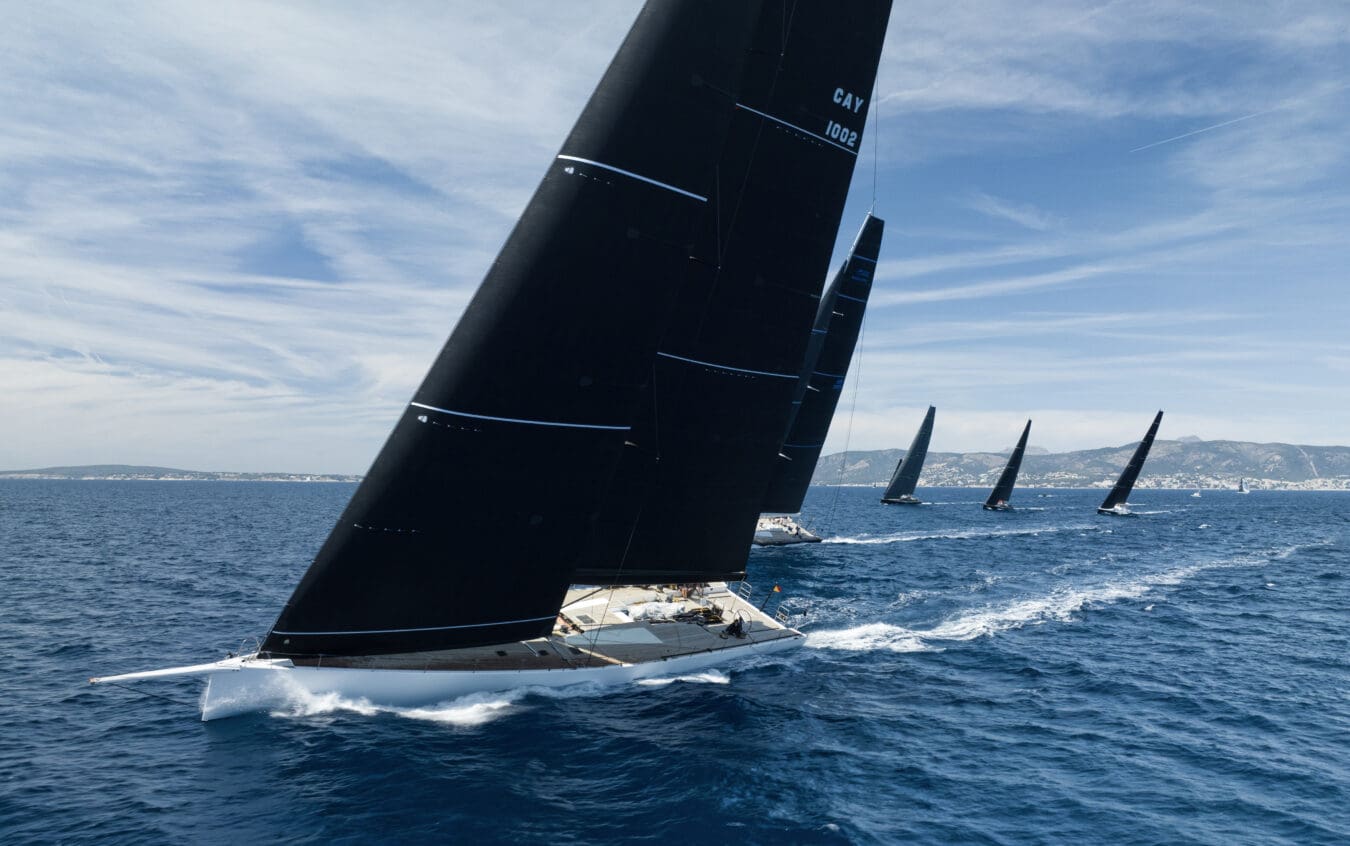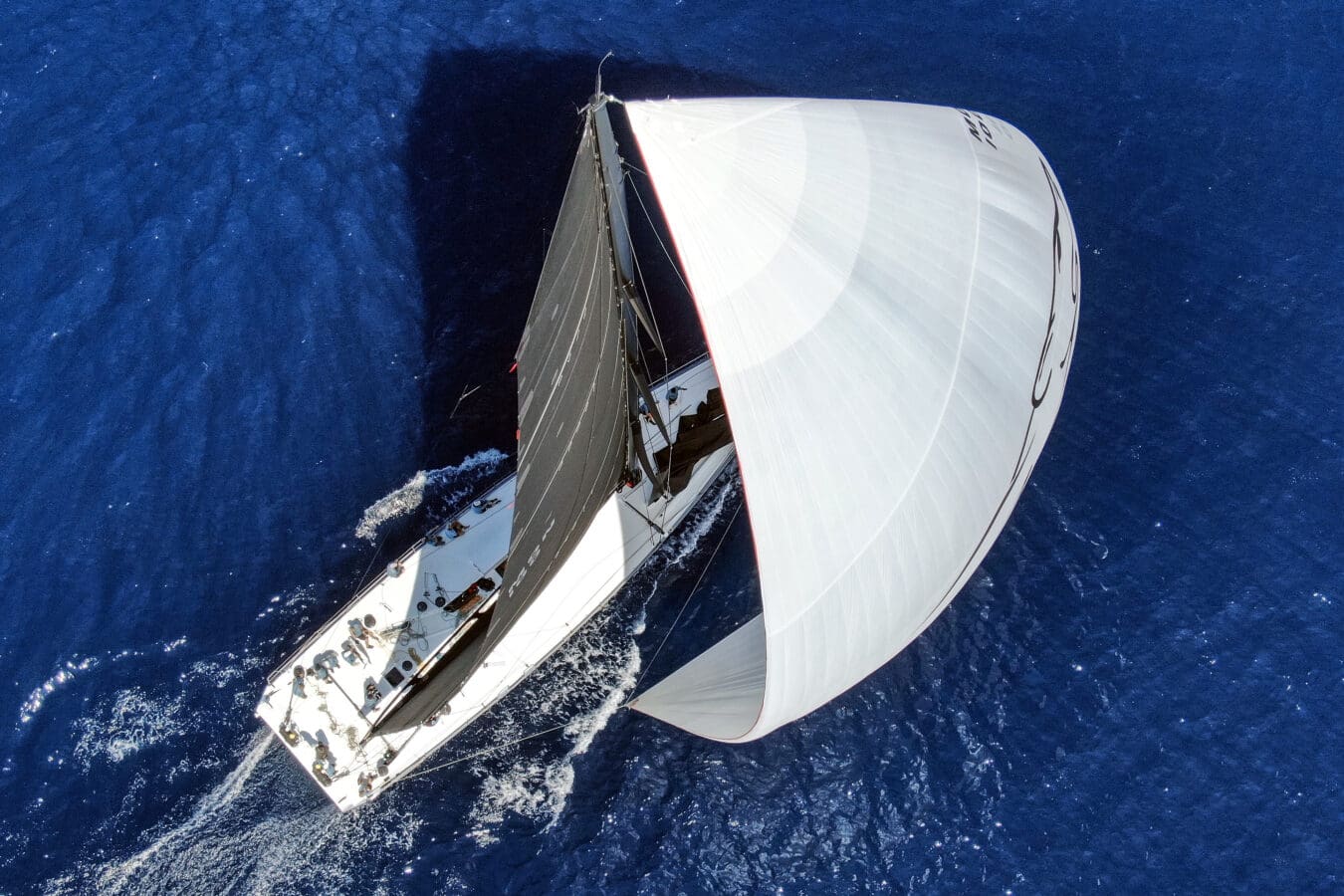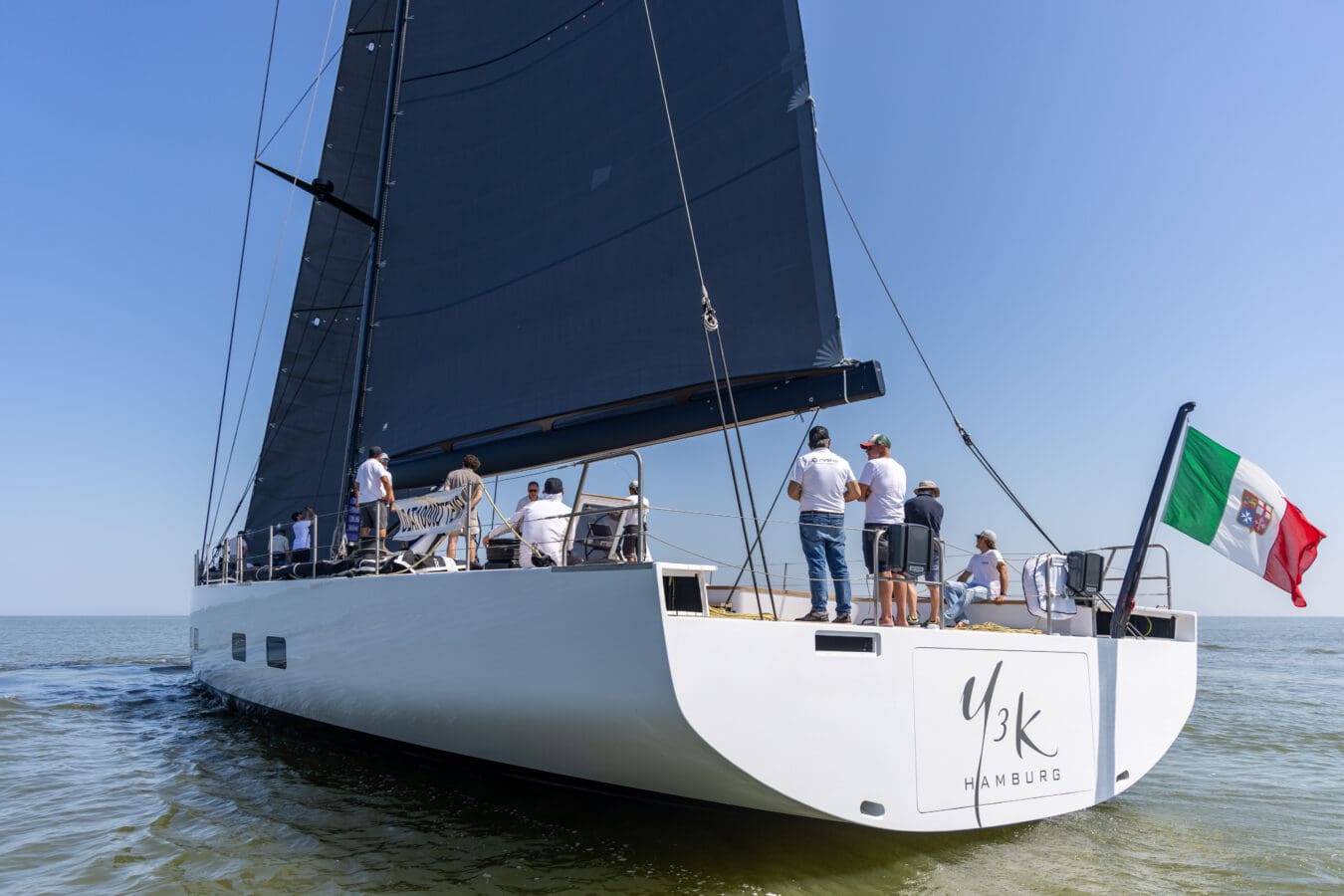(… but still one heck of a finale!)
Doyle Sails builds on success with a renewed focus on next-level R&D
A stellar showing at the 2023 Maxi World Championships might have been just cause for celebration at Doyle Sails. Instead, the mood of quiet satisfaction was eclipsed by a determination to keep focused on pushing the technology, design and development of high-performance sails on their upward trajectory.
‘We are obviously very pleased for the owners and teams who did so well,’ says Doyle Sails CEO Mike Sanderson. ‘We are part of those teams and hope that together we can add more good results next year. We have exciting new products in the pipeline that will move the bar again.’ Business as usual.
Teams racing with Doyle Sails in the Maxi Yacht Rolex Cup included: Maxi A Division – Galateia 1st, Leopard 3 2nd, Bullitt 3rd; Maxi B Division – Bella Mente 1st, Proteus 2nd, Pepe Cannonball 3rd; Super Maxi Division – Y3K 1st; Multihull Division – Convexity 2 2nd equal.
‘This result has been quietly building for quite a long time now,’ says Doyle Sails director and designer Richard Bouzaid, who has been directly involved with all three of the Maxi A podium yachts, along with Proteus, Pepe Cannonball and Y3K. ‘These results are also being backed up in other Grand Prix classes and superyachts.’

For Sanderson, the showing at Porto Cervo is testament to a strategy he has pursued since taking over the leadership of Doyle Sails a dozen years ago. ‘What we are seeing now is the result of a huge investment in sailors and sailmakers, who occupy key positions within high profile Grand Prix and superyacht teams,’ he says.
Behind the company’s ‘by sailors, for sailors’ credo is a hand-picked team of 24 leading sailmakers and Grand Prix sailors who apply to every project experience accumulated from 12 America’s Cups, 30 Volvo Ocean Races, 31 World Championship medals, an Olympic gold medal, multiple maxi regattas and too many national titles to list. ‘We aim to have our people deeply embedded with their respective teams, who believe that having Doyle Sails as part of their team is a sound pillar of what they’re trying to achieve,’ Sanderson explains. ‘They are there because they can help make boats go faster and have earned the respect of the people they sail with on merit, not because of the logo on their shirts.’


But it only works as a dialogue in which the sailmakers respect the particular sailing characteristics of the team and tailor the sail package to their requirements.
Sanderson has a long-standing relationship with Bella Mente, which won Maxi B Division. ‘Doyle Sails do not produce Bella Mente’s sails in isolation,’ he says. ‘Team Bella Mente does that by working with us to produce winning sails. We consult closely with their decision-makers – the owner, afterguard, trimmers and so on. Once you are an integral part of the team and you have proved you can translate their input into reality and repeat that consistently, results follow. With that, you build trust and more results follow. It is the gift that keeps on giving.’
The ideal scenario is to work within a team from the ground up on a new build, or a major refit. Y3K, the stunning newly-launched Judel/ Vrolijk Wally 101, is a case in point. From the outset, Richard Bouzaid collaborated widely with the design team on the rig, deck layouts and structures. ‘The result is a beautiful 30.8m cruiser-racer, which won the Maxi Worlds on its first outing,’ he says. ‘By taking full advantage of the benefits of Structured Luff, right through to components like furlers and hydraulic rams, we were able to reduce headstay loads to between 10.5 and 11 tons.
‘Compare that with the Wally Cento Galateia, which was designed and built for conventional sails with headstay loads up to 26 tons. Since switching to Doyle’s Structured Luff Sails Galateia, which won Maxi Division A, is running headstay loads around 20 tons. This shows you can make improvements by applying Structured Luff to conventional set-ups, but not as much as when the technology is fully integrated throughout the entire design.’
The extensive refit of Leopard 3 was another project that fully embraced the Doyle Sails technology and came storming out of the blocks straight afterwards. Chris Sherlock from the Doyle Sails Palma loft is an integral part of the Leopard 3 sailing team and, with Bouzaid, worked closely with all the relevant disciplines on the programme. Sherlock has been involved with Leopard programmes for 32 years and with Leopard 3 since its build 16 years ago. ‘Currently, I run the race programme and work closely with the boat captain, Gian Ahluwalia, who managed the refit.
‘We began this project with a lot of naysayers but we undertook a massive study before going ahead with it. I always had faith in the boat, which was the last project where Bruce Farr himself drew the lines. ‘Because of charter requirements, the boat was always overweight. We stripped out all the MCA chartering requirements, redesigned the deck layout, replaced half the deck and much of the equipment and built a new rig. The weight went from 51.5 tons to 42 tons. The next step is to get to sub-40 with a new deeper keel fin and lighter bulb and by replacing the daggerboard system, which dates back to 2007.’
‘In many ways this was like a new build,’ says Bouzaid. ‘One of the first decisions was a new rig, so Steve Wilson was brought in early. We worked with Steve, Southern Spars and Farr Yacht Design, providing extensive modelling on the sail load interfaces to get the mast stiffness exactly right for the aero package and to inform decisions about loads going into the deck and structures. ‘The outcome is a 100ft canting- keel maxi race yacht with only 10 tons of headstay tension. These load reductions are amazing when you consider that the headstay tension on a TP52 is 8.5 tons.’
The results speak for themselves. At the Aegean 600 in July, Leopard 3 swept the boards with seven trophies including line and handicap wins and a new monohull race record, then finished 2nd at the Maxi Worlds.
Dramatically reduced headstay tensions are achieved by transferring much of the load onto the Structured Luff sails through the cunningham control. ‘For every ton you put on the sail, you can take two tons off the headstay, with the added bonus of less forestay sag than you had before,’ Bouzaid explains. ‘On a 100-footer, by adding 5 tons to the jib tack load, the headstay load reduces by 10 tons and headstay sag will reduce from about 0.8 per cent to virtually zero – particularly when you consider that, apart from the load reduction, Structured Luff actually projects the sail forward. There are lots of ways you can play with that ratio, but that is how it works.’
On Structured Luff mainsails, higher cunningham loads are largely used to manipulate mast bend. ‘We have used that to good effect with the Maxi 72s, where you can change the mast bend profile quite significantly, even though you are locked in with checkstays,’ Bouzaid notes. ‘We played with this a lot on the AC75s during the last America’s Cup. We were using very high cunningham loads to bend those great big D- section masts. That was very useful on those boats, because you want the sails to be full and powerful when you are going for take-off and then you want them to be super-flat when you are foiling – and you are doing all that without a backstay!’
While best results are obviously best achieved with a new build or a refit on the scale of Leopard 3, even when working with legacy equipment the performance of Galateia, Bullitt, Proteus and others is testament to what can be achieved. A common modification in those cases is to upgrade the hydraulic rams to cope with higher cunningham loads.
Building vital close relationships within teams often proceeds incrementally. ‘Even if it begins with one or two new sails, the switch to a full commitment generally happens quite fast. Otherwise you quickly run into compromises,’ says Sanderson. ‘If you are making a new light jib, for example, do you design it to match the crossovers with the existing heavy jib from a different sailmaker? Or do you build the new light jib with the crossover to match a Doyle Sails heavy jib and fully optimise the potential? It usually doesn’t take long before teams see he advantage of going all-in.’
These team entrenchments set up curious dynamics within Doyle Sails, where a balance has to be struck between internal competition on behalf of rival teams and wider co-operation on progress and development.
‘The teams all have their own programmes and ideas and we must be very respectful of the investment they are making to get an edge,’ Sanderson says. ‘We have had to come up with internal firewalls to deal with that. Where a team has come up with an idea, we are very careful that that IP stays exclusive to that team, until it is in the public domain. Then the race is on for other teams to try to figure it out.’
The benefits are very much a two-way street. Sanderson is the first to acknowledge that he savours the privilege of rubbing shoulders with owners who are highly successful and competitive individuals in their various business fields.
‘I am a huge believer in trying to tap the knowledge and wisdom of people we are associated with. Although we are just a very small part of what they do, many of them are quite passionate about the Doyle Sails story. What they can teach us about building a brand, for example, has value that money can’t buy.’
One of the lessons is that in sport and business, past success – however satisfying – brings with it pressure for continued future achievement.
‘We never stop trying to learn and improve and we are excited about new developments coming on stream,’ says Sanderson. ‘We see our new Hybrid product as a tier above Grand Prix level for teams stretching for those last small percentage gains and we are doing some interesting work with new composite gennakers that could be a big deal in the world of narrow apparent wind angle, high- performance monohulls.’
The work goes on.
www.doylesails.com
ABOUT DOYLE SAILS // As sailors, our obsession with sailing connects us to the water. The water is our playground, a sanctuary where we seek enjoyment, a competitive playing field where we race; it’s sometimes our home and always a place that unlocks our sense of adventure wherever that adventure might take us.
Our obsession with sailing takes us to every corner of the world and onboard every yacht. We become part of teams, share in the adventures of friends and families, sharing our knowledge and experience with those who have the same passion for sailing as we do. Sailing is in our DNA, where the water unlocks our sense of adventure. We are the custodians of a legacy that has been supporting sailors for close to four decades, and while our world changes around us, our commitment to sailors who seek the same enjoyment and adventure as we do hasn’t.
From our sailors to yours, we are your experts in sailing. Your adventure starts with Doyle. By sailors, for sailors.
ABOUT SEAHORSE MAGAZINE // Take advantage of our very best subscription offer or order a single copy of this issue of Seahorse.
Online at: www.seahorse.co.uk/shop and use the code TECH20
Or via email: subscriptions@seahorse.co.uk
